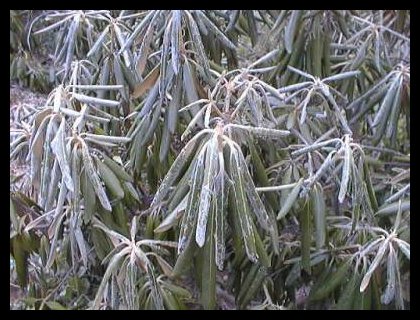Joe Parks, Dover, NH
Rhododendron drought resistance depends almost entirely on root health. It should go without saying that a rhododendron's performance is totally dependant on how healthy and active its roots are. The essentials for healthy roots are:
1. Adequate organic material,
2. Proper soil fertility, and
3. Correct watering.

Organic materials are your first line of defense when faced with water problems. Because they absorb several times their own weight in moisture, organic materials serve as a reservoir for times when rainfall is scarce. But, to be useful, they must be applied early in the season.
Even more important, organic materials promote growth of beneficent soil microorganisms and fungi. Some fungi, mycorrhiza, actually grow into rhododendron roots and provide an additional source of nutrients and moisture. In essence, mycorrhiza expand the size of a root system and increase its uptake of water and nutrients.
Soil microorganisms are also little chemical factories. As they break down organic materials into soil, they convert substantial quantities of chemicals into water soluble nutrients needed by your rhododendrons. These include such micronutrients as copper, manganese, molybdenum, zinc, etc. As if this were not already a veritable goldmine, they also convert aluminum, which kills root tip cells, into a nonpoisonous material. Thus mulch is highly important for improving the drought resistance of roots.
What you use for mulch is very important. The best materials are rather coarse and partially decomposed. This partial decomposition usually takes a year or two here in New England. Fresh mulch materials will, of course, help provide a reserve water supply but the high level of bacterial action during decomposition will deprive your plants of nitrogen. Fresh leaves and grass are particularly poor because they hold large amounts of water and deprive rhododendron roots of much needed oxygen. Leaves should be piled and allowed to decompose for a year or two before using. Any material that can become soggy and pack down, is a no-no because it, too, will cut off the oxygen supply. Peat moss is particularly poor for mulching because it sheds water (instead of absorbing it) when it becomes dry. My favorite mulch is two year old wood chips.
How deep the mulch is is quite important because if it's too deep it also can reduce the oxygen supply. The coarser a mulch material, the more of it that can be used safely. However, about three inches of mulch around a plant should be sufficient. Lastly, be careful to keep the mulch away from the trunk. If mulch becomes piled up around a rhododendron's trunk and keeps it wet above the soil line, deadly phytophthera fungi may invade and kill your plant.
Now, when was the last time you mulched your rhododendrons? If it has been as many as two years, get out there and put another inch on this spring! You'll be adding to the water reserves and also feeding the microorganisms that are important to root health. Remember, poor, unhealthy roots are the first to become water stressed.
Next issue's "NOTES" will be on "hidden hunger" and how to feed your rhododendrons so as to develop strong, healthy roots that will minimize drought stress.
"Life is short, so keep the agenda short. Concentrate on things that are truly important and don't get distracted by the rest."
Robert R. Kiley
The Wall Street Journal, October 14, 1988